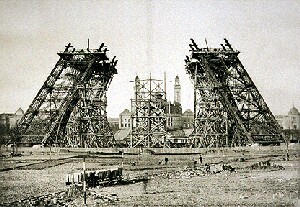|
1 2 3 4 5 6 7 |
 Copyright: Eiffel 1900, T.4, 6-11 |
It was not until the end of 1884, when the Paris International Exhibition had been formally announced, that Eiffel took up the idea for a tower again and set about translating the idea into reality. He bought the rights to the plans from Koechlin and Nougier and secured the approval of the Exhibition's organizing committee for the project.
The next hurdle to be surmounted was a public competition, held in the spring of 1886. But since the plans for the tower had now progressed to the stage of working drawings, the outcome of the two-week competition was never in doubt. Eiffel was granted rights of use to the tower until the year 1910; in return he was required to meet the estimated construction costs of 6.5 million francs out of his own pocket, apart from a state subsidy of 1.5 million francs.
The Eiffel Tower: Facts and Figures
Height: 302.6 m (now 320.8 m with TV mast)
First platform: at a height of 57.63 m, measuring 65 metres along each side
Second platform: at a height of 115.73 m, measuring 65 metres along each side
Third platform: at a height of 276.13 m, measuring 16.5 metres along each side
Number of steps: 1792
Number of lifts: 8
Ground area: 129.22 m
Weight: 7350 tonnes
Number of iron pieces: 12,000
Number of rivets: 1,050,846, driven into 7 million holes by a workforce of 200 men
Daily height increment: 47 cm
Visibility: 85 km
Number of visitors per day: 4,200
Total number of visitors during the 1889 World Exposition: 3,799,040
Admission charges:
2 francs for the first platform
3 francs for the second platform
5 francs for the third platform
Construction costs: 7,799,401.33 francs; state subsidy: 1.5 million francs
| Year: 1889 | City: Paris | Country: France |
| Duration: 6th May - 31st October 1889 | ||